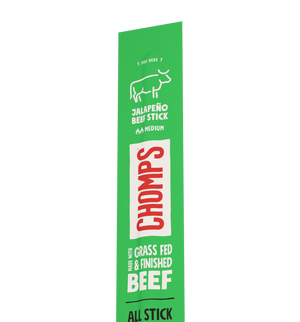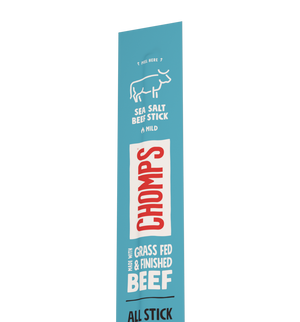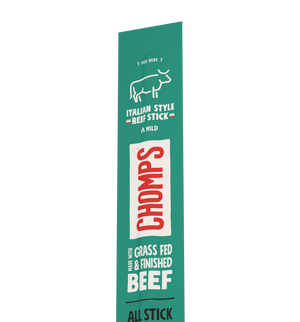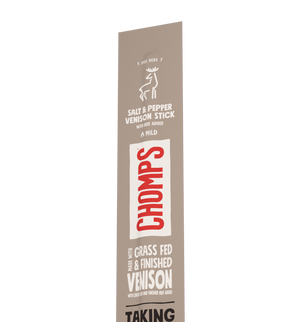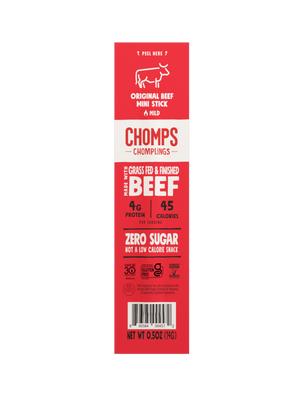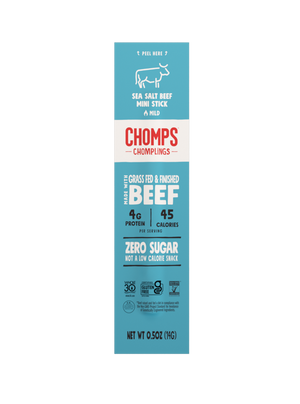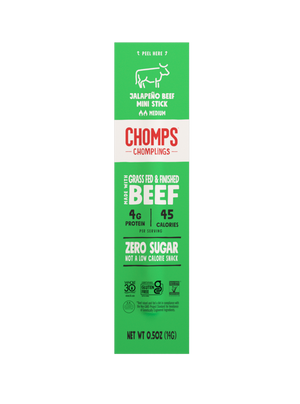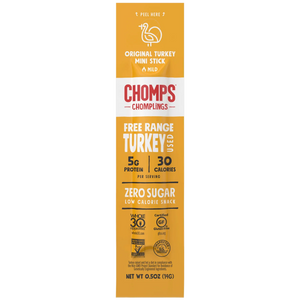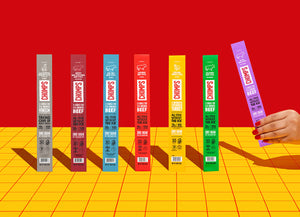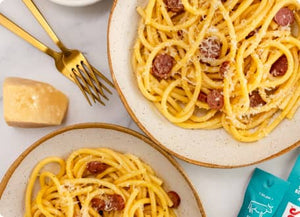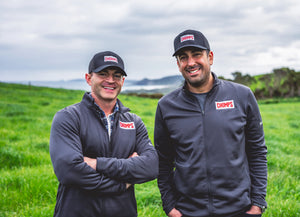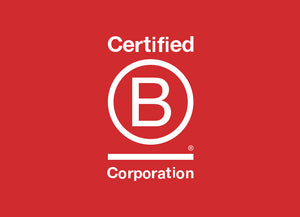As great as elimination diets seem, there are definitely downsides. Restricting substantial parts of your diet can provide short-term results, but studies show that dramatic changes to your diet often lead to burnout, and people who practice less stringent diets tend to maintain healthier weights than those who experiment with highly-restrictive diets[*].
In other words, people who allow themselves grace when it comes to what they eat and what they indulge in and make larger lifestyle changes instead of binging on temporary diets tend to be healthier.
When we consider the role of consistency in how we form habits, it’s no surprise that a series of small behavior changes and decisions that work toward a goal are more sustainable than abrupt, dramatic alterations.
Flexible dieting, while sometimes misunderstood, is the umbrella word for a long-term approach to dieting. It isn’t a diet, per se, but rather a lifestyle approach to eating that customizes your diet to your goals while giving yourself the room to actually enjoy life.
Important: Contrary to “If It Fits Your Macros” die-hards, flexible dieting does not mean you can just eat whatever you want, whenever you want, in any quantity you desire. It’s about eating a mostly healthy diet while not feeling guilty for treating yourself.
Or as one fitness specialist said [*]:
“Flexible dieting is about teaching individuals how to eat an overall “healthy” diet made up of a variety of satiating and nutrient-dense foods while learning how to occasionally incorporate their favorite “unhealthy” foods and making continued progress without accompanying feelings of guilt.”
What Is Flexible Dieting?
Flexible dieting is a personalized nutritional approach that prioritizes macronutrient limits over any specific type of food.
Flexible dieting is also known as “If It Fits Your Macros” (IIFYM) or “Counting Macros”. The idea is that any foods are fair game if they fit your macronutrient requirements for the day.
In a nutshell, flexible dieting is achieved by:
- Calculating your daily caloric needs (TDEE).
- Defining your fitness goals and matching your macronutrient goals to them.
- Tracking and eating foods to meet those goals and/or maintain those limits.
- Developing a healthy diet and lifestyle that allows room for guilt-free indulgences — i.e. maintaining a healthy mindset and relationship to the food we eat.
Does this mean you can eat nothing but twinkies and debbie cakes each day and still lose weight? Technically, yes. If you eat more calories than your body burns, you gain weight. If you eat less, you lose weight[*]. But, that goes against the spirit of flexible dieting and isn’t healthy.
Eating poorly ignores vital micronutrients like vitamins and minerals that your body needs to be healthy. So while flexible dieters acknowledge that they could still lose weight by eating unhealthy foods all of the time, they tend to eat mostly healthy foods (75-80%) while giving themselves the flexibility to indulge in tasty treats when they feel it’s appropriate.
Plus, many flexible dieters incorporate fitness goals into their dietary calculations, and eating a healthy diet makes working out and exercising much easier and more effective.
How to Get Started With Flexible Dieting
Starting with flexible dieting does come with a bit of a learning curve, but putting the time in will pay dividends.
Step 1: Calculate your TDEE
TDEE (Total Daily Energy Expenditure) is a calculation of your body’s resting rate (BMR) and how much exercise you get. In other words, it lets you know how many calories you burn on average each day.
This sets a baseline that you can use to calculate your ideal calorie intake based on your goals. So you can cut by reducing calories, gain by eating more calories, or maintain by eating as many calories as your body needs.
For example, my TDEE is approximately 2,500 calories per day. If I’m eating 2,000 calories a day, then I should lose a pound every week (1lb = ~3,500 calories).
Step 2: Determine your macronutrients needs
Macronutrients are three main nutrients your body uses all of the time. They are fats, proteins, and carbohydrates.
And while fiber is technically a carbohydrate, we argue that you should treat fiber as an honorary macronutrient and track it alongside these main three due to its deep importance to gut health and disease prevention[*].
95% of people in the US don’t get enough fiber each day, denoting a giant gap between the diets of our ancestors and the ultra processed and/or lower-carb diets of the last 100 years[*].
The USDA recommends these typical macronutrient splits [*]:
- Carbs: 45-65% (with 20-30 grams from fiber)
- Protein: 10-35%
- Fat: 20-35%
If your TDEE is 2,000 calories, then your recommended breakdown would be:
- Carbs: 900-1,300 calories
- Protein: 200-700 calories
- Fat: 400-700 calories
And the calorie breakdown for macronutrients is [*]:
- Carbs = 4 calories per gram
- Protein = 4 calories per gram
- Fat = 9 calories per gram
So using the same 2,000 calories example above, this would be your daily recommended macronutrient intake in grams:
- Carbs = 225-325g (with 20-30 grams from fiber)
- Protein = 50g-175g
- Fat = 44-78g
The thing is, your macronutrient needs will change according to your goals and body type. For example, if you are trying to gain muscle, you will probably need somewhere 0.8 to 1.3g of protein per pound each day. If you're a runner gearing up for a marathon, you’ll want to up your carb intake to make sure you have the fuel you need.
It’s also completely possible to practice flexible dieting while temporarily experimenting with other specific diets like Whole30, Paleo, and keto or while manipulating your macronutrient percentages to achieve certain goals. For example, you can carb cycle by boosting carb intake on high-intensity days and lowering it on sedentary days or practice the inverse with fat intake.
Step 3: Track and eat according to your set limits
Once you calculate your TDEE and macros, all you need to do is track what you eat and make sure you reach your goals. This means any food is technically “on the table” as long as you are working within your defined parameters.
For example, if it’s 11 pm and you want a bowl of greek yogurt with extra maple syrup and you know that you have 500 calories and 60g of carbs to spare, then you can make it happen — assuming you have the protein and fat available, too.
Step 4: Work toward a balance
It is possible to flexibly diet and have a completely healthy relationship with food, both mentally and physically.
Remember, the idea behind Flexible Dieting is to adjust it to your needs. If you know that you get into addictive behaviors with calorie counting and scales — don’t use them. Perhaps track for a week or two to establish a baseline and then ditch it, or just make rough estimates from the beginning.
This is about you and only you, so do what you and/or your health professional knows is best.
Benefits of Flexible Dieting
There are many benefits to flexible dieting! Here are a few:
It’s unique to your lifestyle
Because flexible dieting is customized to your life, you can redefine your relationship with food and make it work for you instead of against you.
Whether you’re trying to lose weight, gain muscle, or put on extra pounds, flexible dieting gives you the option to live a balanced life while working toward your goals.
It reduces burnout
Restrictive diets are hard. Going months without a sweet snack or slice of pizza can be extremely difficult.
While intense diets can be useful to snap yourself out of a slew of bad eating habits, “unhealthy” food isn’t inherently bad. Fatty and sweet foods are delicious, and part of living a balanced life is treating yourself and enjoying them from time to time.
It’s way better to eat mostly healthy and treat yourself consistently than eat really healthy for a month and then go back to eating poorly all of the time. Balance is key.
It’s a healthy approach to being healthy
Balance is better for your mental health, too. When we experiment with highly restrictive diets we are more likely to become obsessed with calorie counts, our weight, how we look, and feel guilty when we eat unhealthy foods[*][*][*].
If we live generally healthy lives with flexible dieting and resist developing toxic relationships to food, we can live longer and happier.
Downsides of Flexible Dieting
Requires a bit of upfront work and expertise
Because you need to know your TDEE and establish your macro goals, it may not seem as easy as other diets like keto, where all you have to track is carbs.
You have to know a bit about nutrition to understand what macros are, how to set appropriate fitness goals, and what even eating a mostly healthy and diverse diet means.
This is where a professional can help, but you can definitely do it with a bit of research and tweaking.
But that doesn’t mean it’s not worth the effort!
These are good things to know anyway. Calculating your TDEE takes just a minute or two, and figuring out and tracking your macros for a week or two to get an idea of your normal is information that is uniquely yours and will serve you for a long time.
That being said, remember that online calculators are estimates. The only way you can see if your diet is working for you is by tracking your results and adjusting accordingly. If you’re eating 500 calories over your TDEE but aren’t gaining weight, then your TDEE is higher than the calculator reported.
Doesn’t track micronutrients as closely
Some nutritionists argue that because macronutrients are so broad, you could make poor diet choices within flexible dieting. For example, you could get all of your fat for the day from saturated fats, which isn’t ideal [*].
But, as long as you’re consistently eating whole, natural foods for most of your diet, you shouldn’t have anything to worry about. And if you are worried, then get your blood done periodically or meet with a professional to ensure your body has what it needs.
No real structure to rely on
Dieting with a strict plan can help with motivation and accountability, and flexible dieting is definitely a lifestyle suited for those who are used to building their own systems and habits.
While there are some flexible dieting communities, the point is to customize it to your needs, which cannot be generalized.
Tips for Making Flexible Dieting Work
Download an app
Having a tool like MyFitnessPal that can input nutritional data based on barcodes and remember recurring meals is a huge help when eating a flexible diet.
It will take a bit to get all of your normal foods in the app, but once you do you’ll be able to easily track what nutrients you got and when.
Get a scale
If you’ve had issues with getting addicted to your scale, please skip this, but scales can be helpful to understand if your cut, bulk, or maintain cycles are actually working.
If you think you’re bulking but are staying the same weight, then you need to up your calorie intake.
Don’t feel like you have to track everyday
It can be taxing to track everything all of the time, especially when we are eating out with friends or hosting a dinner. Give yourself the space to enjoy life and lay off the dieting brakes when you need to. You’ll find that you’ll be happier and see better results.
Calculate everything before you start
Hit the ground running with your TDEE, your specific fitness goals (if you need them), and your ideal macronutrient intake. This lets you see if what you’re doing in the kitchen and gym is actually working.
See if your calculations match your results
Monitor your actual results against your calculations. If you’re bulking an extra 500 calories a day, then you should see an extra pound in 7 days. If your scale tracks body fat and muscle, see how much of that pound went to what.
Tip: People tend to underestimate protein and overestimate fat and carbs.
See if your body fat and composition changes
Weight isn’t everything. Track your muscle growth, see if you notice areas of your body toning out or beefing up, and remember — it’s about mental health as well. If you feel good while flexible dieting, then it is good.
Don’t use flexible dieting as an excuse
Hitting your macros isn’t an excuse to eat ice cream and fried chicken every day. You still need to eat a balanced diet and prioritize eating healthy vegetables, avoid added sugar (unless you’re treating yourself), and generally eat well.
Otherwise, you fall into the trap that nutritionists criticize flexible dieting over — it can just become a form of self-justification that lets you continue with detrimental habits.
The Bottom Line
Flexible dieting is a customized approach to eating that prioritizes fitness goals, happiness, and lifestyle balance over any particular food eliminations. It’s about living a healthy life — both mentally and physically, and that is achieved through tracking your progress toward your unique goals via macronutrients and giving yourself the space to indulge when life calls for it.
Because it isn’t systemized, it’s not for everyone. It requires self-discipline and consistent will, but if you manage to adapt and achieve what flexible dieting can offer, you are likely to live a healthier, happier, and richer life.


